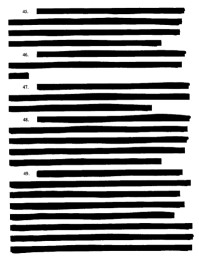Hollywood offers valuable reminders of the stake we all have in The Fourth Estate. More than ever, we need the Daily Planet’s Clark Kent more than Superman.
One of the durable genres of television is the police procedural. From its inception, the medium has put a spotlight on dramas about crimes, and the efforts of various law enforcement figures to solve them. This durable form is seen in feature films as well. But I would argue that the best kinds of “procedurals” on film have focused on investigative journalists rather than cops. Within the vast library of motion pictures that are still worthy of our attention there are at least six riveting narratives about official misconduct—actual or plausible– uncovered by working journalists. These dramas piecing together discovered evidence tell us how journalism in civil society should work. While entertaining, they are also valuable reminders of the stake all Americans have in The Fourth Estate; It’s good for our national soul to have these circulating in the culture. Alarmingly, a recent example, Steven Spielberg’s The Post, is six years old. At some point we need to refocus our interest in journalistic sleuths rather than superheroes that are not of us. We need Clark Kent more than Superman.
All my selections here focus on national media, but there are also cases where local media outlets flexed their own investigative muscles to shine a light on a dark corner in a community. Unfortunately, with the decline of good local newspapers, local investigative reporting seems to happen less often.
Consider seven features that represent the best of this canon.
All The President’s Men
This is well-known Woodward and Bernstein print account of press exposure of Richard Nixon’s coverup of his party’s break-in at the Watergate residential complex is riveting. Their reporting set up the resignation of the President and remains one of the best examples of official malfeasance exposed. The 1976 film adapted from the book is directed by Alan J. Pakula, and shows what can be done when an editor gives reporters time to piece together the backstory of a political crime. It helps, too, to have Dustin Hoffman. Robert Redford and Jason Robards in the cast. Robards plays Ben Bradlee, the kind of editor the nation and an investigative journalist needs.
The Post
One of the most interesting press figures in the last century was surely Katherine Graham, who took over as publisher of the Washington Post after the suicide of her husband, Phil Graham. The film 2017 film directed by Stephen Spielberg is a fascinating study of a woman finding her feet in the turbulent world of a news outlet in the nation’s capitol. The film focuses on her decision to publish a government report the government sought to keep secret. Publishing the Pentagon Papers helped to expose the leadership nightmare that led the quagmire of the Vietnam War. Over its 116 minutes, Meryl Streep shows us the emerging courage of Kay Graham, this time, with Tom Hanks in the role of Ben Bradlee.
Spotlight
This is a 2015 account of efforts at the Boston Globe to expose the abuse of children by clergy in this traditionally Catholic city. It’s a text book procedural study: what it takes to build an ironclad story that others had not bothered to document. The reporters for an investigative unit within the paper are relentless in following up leads to coax adults still traumatized by sexual encounters to tell their stories. Boston’s Cardinal Bernard Law is the untouchable leader who abetted the concealment of abuse committed by 90 priests within the Boston Archdiocese. The investigation chronicled in the film opened up national awareness about the problem. Tom McCarthy directs a perfect cast from a script by himself and Josh Singer. The actual print coverage that is the subject of the film won a Pulitzer for the paper, and the film won the Oscar for Best Picture.
Good Night and Good Luck and Broadcast News
In the past, no news network has come under more deserved scrutiny than CBS. Both of these films owe a lot to books and accounts produced by former CBS staffers, who watched their news division whither in the 1980s. Good Night and Good Luck is a reasonably accurate account of earlier battles between journalist Edward R. Murrow and his producer, Fred Friendly, and the nervous head and founder of the network, William Paley. In the 50s and 60s the “Tiffany network” kept a well-staffed and independent news division, with Murrow (played perfectly by David Strathairn) as its conscience. Murrow wanted the network to cover the excesses of Senator Joseph McCarthy, who was then terrorizing Americans with an extended hunt for alleged subversives in government and the arts. Friendly, Murrow and their team confronted McCarthy in a prime-time broadcast, threatening Paley’s determination to not upset his lucrative money machine of prime time. George Clooney directs this classic tale of journalistic integrity seen with a lot of cigarette smoke and extreme close ups. It also highlights the conundrum of how to deliver the kinds of news Americans should know in the face of competition from the likes of The Beverly Hillbillies. This 2005 film is still relevant as a reminder of how media outlets must balance their coverage against the wishes of advertisers, who would generally prefer that coverage of darker American events not clutter their sponsored programs.
Broadcast News offers a semi-fictionalized account of editorial pressures within the news business, all informed by the experiences of former CBS news producer, Susan Zirinsky. Director James Brooks has always made wonderful dramadies, and Broadcast News from 1987 matches his sensibilities perfectly. Beyond its modest love story is a troubling look at how the entertainment values of mainstream television do not meld easily with the need to keep television news visual and interesting. William Hurt gets the challenging role of Tom, who looks like a news anchor but can’t think like one. Jane is Susan’s avatar here, played by Holly Hunter, and signed on to the film just before shooting began. Hunter’s Jane owns the film by becoming its Edward R. Murrow. Even while she is attracted to Tom, she’s truly appalled at what he does not know about how to do first-rate television journalism. As with CBS, they ride out a long winnowing out of the news division in favor of profits and the prime time schedule.
The Paper
Against a narrative of Henry and Martha negotiating their marriage together, Henry finds it hard to get away from the obligations of accurately reporting crime news for a New York tabloid. As a general assignment reporter Henry is up against the inclination of his paper to run a stories that rile up readers, even two African American teens are wrongly linked to a crime. Henry is sure of their innocence, but has less than 24 hours to prove it before the presses roll. Michael Keaton is fully believable as a journalist with standards, but he is up against cynical editors that are ready a public appetite for easy scapegoats. Ron Howard’s 1994 melodrama plays like a great race. Will he get enough proof in 24 hours to kill a story that will destroy the lives of the teens? Along the way, he manages to include one of the oldest and greatest tropes in all of print journalism: reporters in the building suddenly feeling the vibrations of the floor, as the massive letterpress machinery downstairs begin to roll. Call me old fashioned, but the sounds of a city paper turning out another “one-day miracle” will always be music to a free society. Keaton deserves at least an honorary press pass for appearing in two of these films.
She Said
Since first posting this piece I’ve screened a worthy addition to the list: She Said (2022), directed by Maria Schrader. Much like Spotlight, the film shows two New York Times Journalists working to piece together a story on the criminal abuse of women by Harvey Weinstein. Jodi Kantor and Megan Twohey worked for months to get women to open up about the abuse the encountered working for the iconic Hollywood produced. Some had signed no-disclosure agreements, making their work in documenting cases all the more difficult.
It may seem “old school” to focus on narratives based mostly on print journalists. Folks at Vice, ProPublica, and Vox are partly picking up t he slack. But Twitter and Instagram are obviously not going to cut it. There’s too much noise if everyone pretends to be a journalist. We are in trouble as a democracy if we don’t find ways to give our attention to real journalists–digital or print–who need time and support to expose institutional and governmental lapses.
![]()

